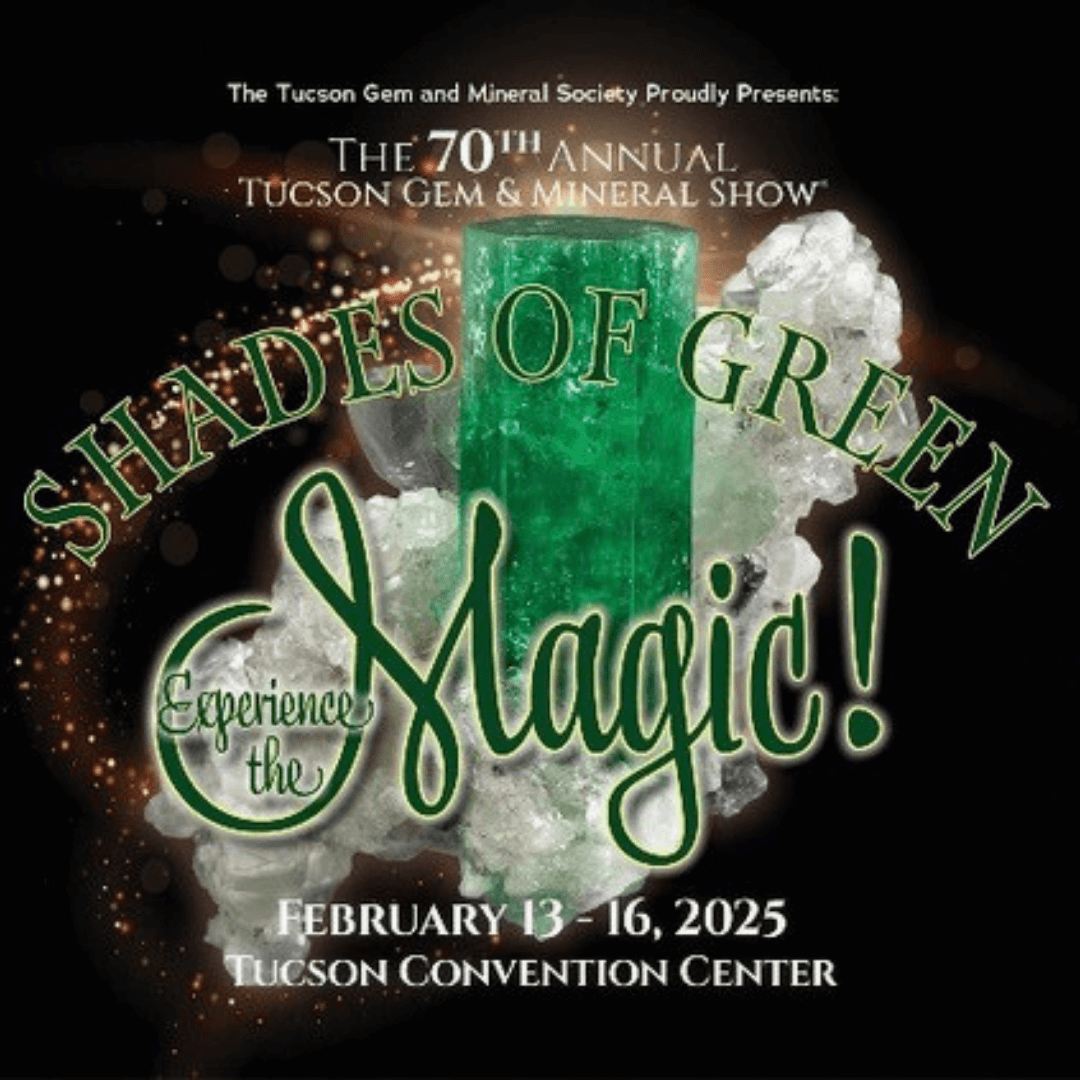Shades of Green – Experience the Magic is the theme for the 70th Annual Tucson Gem & Mineral Show®. Sponsored by the Tucson Gem & Mineral Society, Inc., the show will take place February 13-26, 2025, at the Tucson Convention Center. The theme is foretelling of the huge cornucopia of green gems and minerals on exhibit that will enchant visitors and perhaps cast a magical spell.
Green-colored gemstones are part of almost every mineral group. Famous members include emeralds (beryl); chrysoprase, bloodstone, aventurine, imperial jasper, kabamba jasper, and ocean jasper (quartz); green tourmaline; green sapphires; nephrite jade and imperial green jadeite; as well as tsavorite, grossular, demantoid, and drusy uvarovite (garnets).
There are also the soloists: malachite, amazonite, chrysoberyl, chrome diopside, maw-sit-sit, drusy liebethenite from Congo, fluorite, peridot, gaspeite, lime magnesite, seraphinite, prehnite, idocrase, and serpentine.
Green gems vary in hue, chroma (saturation), lightness, and tint, each with an identifiable green shade. They evoke memories of picturesque and scenic vistas, gardens, and lush meadows. Green is considered relaxing and pleasing to the eye and symbolizes nature, spring, healing, fertility, rebirth, and regeneration. It is linked to over thirty similes, idioms, and phrases used in everyday language.
There is an abundance of green gem materials available to lapidaries and designers, from transparent green gems suited for faceting to translucent and opaque materials ideal for cabbing, carving, beads, eggs, and spheres.
Emeralds from Colombia, Brazil & North Carolina
Emerald, the green gemstone variety of the mineral beryl, is typically colored by chromium and, more rarely, by vanadium. Famous emerald mines include Colombia’s Muzo and Chivor mines and ancient mines in Egypt, India, and Austria. Today, emeralds are also mined in Zambia, Mozambique, Madagascar, Zimbabwe, Canada, and North Carolina. Emerald is the birthstone for May.
A unique variety of emerald, called Sugarcane Emerald, was discovered in Campo Formoso, Brazil, in 2007. It appears in shades of pastel-green and bluish-green with white mottled veins and a bamboo stalk-like appearance. Well-developed hexagonal crystals exhibit pronounced whitish band zoning, parallel to the crystal faces. Sugarcane Emeralds are considered rare, since no additional material has been discovered.
Emerald in matrix, also known as Crabtree Emerald, is found in North Carolina’s Crabtree Mine. It is actually a rock composed of white feldspar serving as the background canvas against which sprays of black tourmaline needles intersperse with glittering mica and perfect little bright green emerald crystals. The Crabtree Emerald Mine is located about four miles southwest of Spruce Pine, in the Grassy Creek Township of Mitchell County, in the scenic Blue Ridge Mountains of western North Carolina.
Gaspeite
Gaspeite is a nickel, magnesium, and iron carbonate mineral [(Ni, MG, Fe) CO3] with a neon lime green color resulting from its nickel content. The name gaspeite comes from its original discovery location, the Gaspé Peninsula in Quebec, Canada. The other famous location is in Western Australia, about 300 km southeast of Perth, at the nickel sulfide mines of Kambalda, south of Kalgoorlie, near the town of Widgiemooltha. In the early 1990s, gaspeite was stockpiled at mine dumps as nickel ore. It was introduced to the Tucson market by an American gemstone dealer as a new lapidary material in 1997. Gaspeite was an instant hit with lapidaries and designers due to its attractive and unmistakable electric lime green color.
Gaspeite is often associated with a brown iron veining matrix which gives the material a distinctive appearance and can present muddy cutting conditions. Gaspeite may also include limonite, goethite, and hematite. With a hardness of 4.5-5, it is often cut with turquoise and coral for inlay and intarsia work by contemporary Native American jewelry artists. Early gaspeite material, which was purely green, was hard enough to be cut without any treatments, while material with heavy brown veining is typically stabilized. As the original rough stocks diminish, the prices for rough and cut stones are rising.
Green garnets
The garnet group includes several green members: grossular mint garnets (Merelani), green-golden garnets (Mali), and demantoid, a rare green variety of andradite garnet (a calcium and iron-rich garnet) from the Ural Mountains in Russia. The deep green tsavorite garnet, colored by trace amounts of vanadium or chromium, was discovered in 1967 by gem prospector and geologist Campbell Bridges in northeastern Tanzania.
Drusy uvarovite garnet, one of the rarest garnets, is a calcium chromium-bearing garnet with the chemical formula Ca3Cr2(SiO4)3. Occurring as minute, well-formed crystals, uvarovite often forms as a vivid emerald-green fine drusy crust on top of a dark chromite matrix. Uvarovite was discovered at Saranovski Mine, in Sarany, in the Urals Region of Russia, in 1832 by Germain Henri Hess (1802-1850), a Swiss-Russian chemist and doctor. Hess named the uvarovite garnet after Count Sergei Semenovitch Uvarov (1765-1855), who was an influential Russian statesman under Czar Nicholas I of Russia and an amateur mineral collector.
Uvarovite garnet is evaluated on how tightly and uniform the crystals are packed, preferably with no exposed matrix surface. Personally, when line-engraving the drusy, I like the contrast between the vibrant green drusy and the dark chromite background.
Chrome Diopside
Chrome diopside is a bright green-colored gemstone with chemical formula CaMg (Fe, Cr) Si206 and a Mohs hardness of 5-6. Distinguished by its deep green color and impressive refractive index of 1.66-1.73, chrome diopside yields brilliant, dazzling cut stones. Mined exclusively in the frost-bitten highlands of Eastern Siberia, Yakutia, in Russia, it is nicknamed “The Russian Emerald”. Chrome diopside was introduced to the U.S. trade market in 2003 and sold under the trade name Sibirlite™, reflecting its mining origin.
Peridot
Peridot, the olive-green gem variety of the mineral olivine, has a chemical formula of (Mg, Fe)2SiO4 and a Mohs hardness of 6.5-7. Peridot occurs in volcanic basalt rocks and pallasitic meteorites.
Peridot, mined on St. John’s Island in the Red Sea since 300 BC, was well-known in the ancient world. Today, it is found in Hawaii, Pakistan, and many other world localities, including the San Carlos Apache Indian Reservation in Arizona. Peridot is the primary birthstone for the month of August.
Come See Us at the TGMS® Show
We hope the theme Shades of Green —Experience the Magic at the 70th Annual Tucson Gem & Mineral Show® will cast a spell and inspire you to collect or create artwork with green gemstones. With over 200 dealers’ booths, you’re sure to find green treasures to take home or simply appreciate and admire the amazing specimens brought in by museums and private collectors as guest exhibits, all showcasing the show’s theme.
I will be at my Gem Art Center/Helen Serras-Herman Booth #1601 in the Ex Hall featuring my Shades of Green Collection. Looking forward to seeing all of you!




